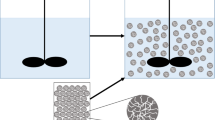Abstract
The stability and, consequently, the lifetime of immobilized enzymes (IME) are important factors in practical applications of IME, especially so far as design and operation of the enzyme reactors are concerned. In this paper a model is presented which describes the effect of intraparticle diffusion on time stability behaviour of IME, and which has been verified experimentally by the two-substrate enzymic reaction. As a model reaction the ethanol oxidation catalysed by immobilized yeast alcohol dehydrogenase was chosen. The reaction was performed in the batch-recycle reactor at 303 K and pH-value 8.9, under the conditions of high ethanol concentration and low coenzyme (NAD+) concentration, so that NAD+ was the limiting substrate. The values of the apparent and intrinsic deactivation constant as well as the apparent relative lifetime of the enzyme were calculated.
The results show that the diffusional resistance influences the time stability of the IME catalyst and that IME appears to be more stabilized under the larger diffusion resistance.
Similar content being viewed by others
Abbreviations
- C A, CB, CE mol · m−3 :
-
concentration of coenzyme NAD+, ethanol and enzyme, respectively
- C p mol · m3 :
-
concentration of reaction product NADH
- d p mm:
-
particle diameter
- D eff m2 · s−1 :
-
effective volume diffusivity of NAD+ within porous matrix
- k d s−1 :
-
intrinsic deactivation constant
- K A, K′A, KB mol · m−3 :
-
kinetic constant defined by Eq. (1)
- K xA mol · m−3 :
-
kinetic constant defined by Eq. (5)
- r A mol · m−3 · s−1 :
-
intrinsic reaction rate
- R m:
-
particle radius
- R v mol · m−3 · s−1 :
-
observed reaction rate per unit volume of immobilized enzyme
- t E s:
-
enzyme deactivation time
- t r s:
-
reaction time
- V mol · m−3 · s−1 :
-
maximum reaction rate in Eq. (1)
- V x mol · m−3 · s−1 :
-
parameter defined by Eq. (4)
- V f m3 :
-
total volume of fluid in reactor
- w s kg:
-
mass of immobilized enzyme bed
- β :
-
factor defined by Eqs. (19) and (20)
- ϱ kg · m−3 :
-
density of immobilized enzyme bed
- ϰ:
-
unstableness factor
- η :
-
effectiveness factor
- φ :
-
Thiele modulus
- Θ :
-
relative half-lifetime of immobilized enzyme
- o :
-
values obtained with fresh immobilized enzyme
References
Vasić-Rački, D.; Gjumbir, M.; Husadžić, B.: Diffusion resistance and enzyme activity decay for yeast alcohol dehydrogenase immobilized on anion exchange resin. Preprints of the 3rd European Congress on Biotechnology, vol. 3, pp. 455–461. Dechema, Weinheim
Ooshima, H.; Harano, Y.: Effect of intraparticle diffusion resistance on apparent stability of immobilized enzymes. Biotechnol. Bioeng. 23 (1981) 1991–2000
Bailey, J. E.; Ollis, D. F.: Biochemical engineering fundamentals, pp. 95. New York: McGraw Hill 1977
Aris, R. A.: The mathematical theory of diffusion and reaction in permeable catalysts, vol. 1. Oxford: Clarendon Press 1975
Aris, R. A.: A normalization for the Thiele modulus. Ind. Eng. Chem. Fundamentals 4 (1965) 225–229
Vasić-Rački, D.: Immobilization of yeast alcohol dehydrogenase on weakly basic anion exchange resin beds. Croat Chem. Acta 57 (1984) 305–311
Ford, J. R.; Lambert, A. H.; Cohen, W.; Chambers, R. P.: Recirculation reactor systems for kinetic studies of immobilized enzymes. Biotechnol. Bioeng. Symp. No. 3 (1972) 267–284
Horecker, B. L.; Kornberg, A.: The extinction coefficients of the reduced band of pyridine nucleotides. J. Biol. Chem. 175 (1948) 385–390
Smith, J. M: Chemical engineering kinetics. New York: McGraw Hill 1981
Gjumbir, M.; Vasić-Rački, D.: Numerical estimation of the initial reaction rate and kinetic parameters of biocatalytic ethanol oxidation. Chem. Ind. 39 (1985) 95–100
Butt, J. B.: Reaction kinetics and reactor design, p. 388. New Jersey 1980
Regan, D. L; Lilly, M. D.; Dunnill, P.: Influence of intraparticle diffusional limitation on the observed kinetics of immobilized enzymes and on catalyst design. Biotechnol. Bioeng. 16 (1974) 1081–1093
Author information
Authors and Affiliations
Rights and permissions
About this article
Cite this article
Vasić-Rački, D., Gjumbir, M. Intraparticle mass-transfer resistance and apparent time stability of immobilized yeast alcohol dehydrogenase. Bioprocess Engineering 2, 59–63 (1987). https://doi.org/10.1007/BF00369524
Received:
Issue Date:
DOI: https://doi.org/10.1007/BF00369524




